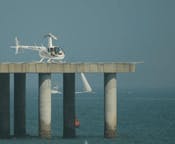The U.S. Environmental Protection Agency’s helicopter, the “Coastal Crusader,” is tuned-up and ready for action and so is the Agency’s summer monitoring program. While the Coastal Crusader is scanning the New York and New Jersey harbor for floating debris that could make its way to area beaches, EPA scientists will be evaluating a new cutting-edge rapid water quality test that can identify harmful pathogens in a fraction of the time the traditional test takes.
The Agency will analyze samples collected through the monitoring programs conducted by local authorities. EPA will further support New Jersey and New York’s beach monitoring programs by providing them almost $1 million in grants to help them test for pathogens in recreational waters.
“When people go to the beach they want to have fun, relax and enjoy all the beauty that New Jersey and New York’s coastlines have to offer,” said Alan J. Steinberg, EPA regional administrator. “By scanning the inshore waters for floating debris, helping fund state and local beach monitoring programs, and working to put advanced scientific tools into the hands of local officials, EPA is truly doing its part to safeguard our sand and surf.”
Between Memorial Day and Labor Day, EPA uses the Coastal Crusader to search for floating debris that can wash up on area beaches. Information is given to the U.S. Army Corps of Engineers, which uses skimmer vessels to remove debris from the surface water and ensure that no floating debris is washed ashore on area beaches.
This year, in cooperation with the New Jersey Department of Environmental Protection, the Agency will use water samples collected by health departments in Monmouth and Ocean Counties in New Jersey to do a special side-by-side comparison of two different tests used to detect harmful pathogens. The commonly used method takes 24 hours to yield results, while the new method can take as little as three hours. The sensitivity, accuracy and precision of the new method will be examined and compared with results obtained from the traditional method. Results of this evaluation will be published and shared with beach communities in New Jersey and New York to determine the effectiveness and usefulness of the new test and help further refine the test for use by local and state authorities.
EPA also awards funds to both New Jersey and New York each year under the Beaches Environmental Assessment and Coastal Health Act ( BEACH Act ) to make beach monitoring programs more consistent nationwide, improve water quality testing at the beach, and help beach managers better inform the public about water quality problems. The act authorizes EPA to award grants to help eligible states, tribes, and territories develop and implement beach water quality monitoring and notification programs. This year, EPA will give New Jersey $441,955, and New York $512,965.
Source: EPA


